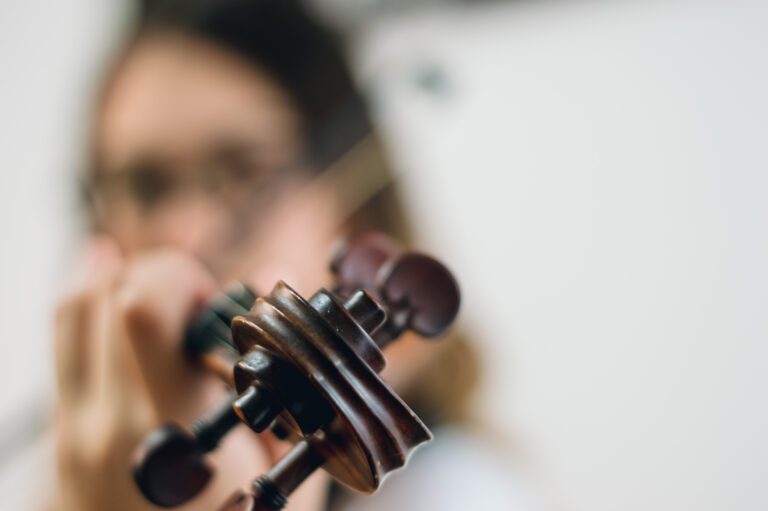Can Violin Be Self-Taught?
The violin is one of the most beautiful and expressive instruments to learn, but it’s also considered one of the most challenging. Traditionally, students learn the violin under the guidance of a teacher, but many aspiring musicians wonder: can violin be self-taught? The answer is yes—with the right approach, resources, and dedication, you can teach yourself to play the violin. However, there are important factors to consider.
This guide explores how to self-learn the violin, the challenges you might face, and tips to make your learning journey successful.
1. Is It Possible to Teach Yourself the Violin?

Yes, it’s possible to teach yourself violin, but the learning process might take longer and require more discipline compared to learning with a teacher. You’ll need to rely heavily on self-motivation, attention to detail, and external resources like online tutorials, books, and apps.
Self-learning works best if you:
Have a strong commitment to regular practice.
Are comfortable troubleshooting mistakes on your own.
Use quality learning materials and tools.
2. What Are the Benefits of Self-Teaching?
Teaching yourself violin has several advantages:
Flexibility: Learn at your own pace and schedule.
Cost-Effectiveness: Save money on lessons by using free or affordable resources.
Personalized Learning: Focus on the styles or techniques that interest you most.
3. Challenges of Learning Violin on Your Own

While self-learning is possible, it comes with some challenges:
1. Lack of Feedback
Without a teacher, it’s harder to identify and correct mistakes like poor posture, incorrect bowing, or intonation issues.
2. Slower Progress
You may take longer to master techniques without guided instruction.
3. Risk of Bad Habits
Improper posture, hand placement, or bowing technique can lead to bad habits that are difficult to fix later.
4. How to Teach Yourself Violin: A Step-by-Step Guide

1. Get the Right Equipment
Invest in a good-quality beginner violin that suits your size. Ensure it is properly set up with tuned strings, a quality bow, and rosin.
2. Learn the Basics
Violin Anatomy: Familiarize yourself with parts of the violin (fingerboard, bridge, strings) and bow.
Proper Posture: Learn to hold the violin and bow correctly. Good posture prevents strain and improves technique.
Basic Techniques: Start with bowing on open strings and finger placement.
3. Use Reliable Learning Resources
YouTube Tutorials: Channels like Violin Lab and Eddy Chen provide beginner-friendly lessons.
Books for Beginners: Try Essential Elements for Strings or Suzuki Violin School Volume 1.
Apps: Use apps like Trala or Violin Tutor Pro for guided lessons and feedback.
4. Practice Regularly
Consistency is key to progress. Practice daily for at least 20–30 minutes, focusing on specific techniques like:
Bowing exercises.
Scales and arpeggios.
Beginner songs like Twinkle, Twinkle Little Star.
5. Record Yourself
Record your practice sessions to identify mistakes and monitor progress. Listening to your recordings can help you improve intonation and rhythm.
6. Play Along with Backing Tracks
Playing with backing tracks improves timing, rhythm, and confidence. Start with simple pieces and gradually increase difficulty.
7. Seek Feedback
While you’re teaching yourself, consider occasional feedback from experienced players or online communities. Join forums, groups, or attend workshops to connect with others.
5. When to Consider Professional Guidance

Even if you’re self-taught, there might be times when professional lessons are helpful, such as:
Struggling with advanced techniques like vibrato or shifting.
Preparing for performances or exams.
Fixing bad habits that hinder progress.
At The Mystic Keys, we offer personalized one-on-one violin lessons online. Our experienced teachers can guide you through specific challenges and accelerate your learning.
6. Self-Learning vs. Lessons: What’s Right for You?

Self-Learning works well if:
You’re highly self-motivated.
You prefer a flexible schedule.
You’re okay with slower progress and occasional mistakes.
Lessons with a Teacher are better if:
You want structured guidance.
You need help with advanced techniques.
You’re preparing for exams or performances.
Yes, the violin can be self-taught, but it requires dedication, patience, and careful attention to detail. With the right resources and consistent practice, you can build a strong foundation and play simple pieces within a few months. Remember to stay disciplined, monitor your progress, and seek help when needed.
Ready to elevate your violin skills? Explore online violin lessons at The Mystic Keys and enjoy personalized guidance from expert teachers.








